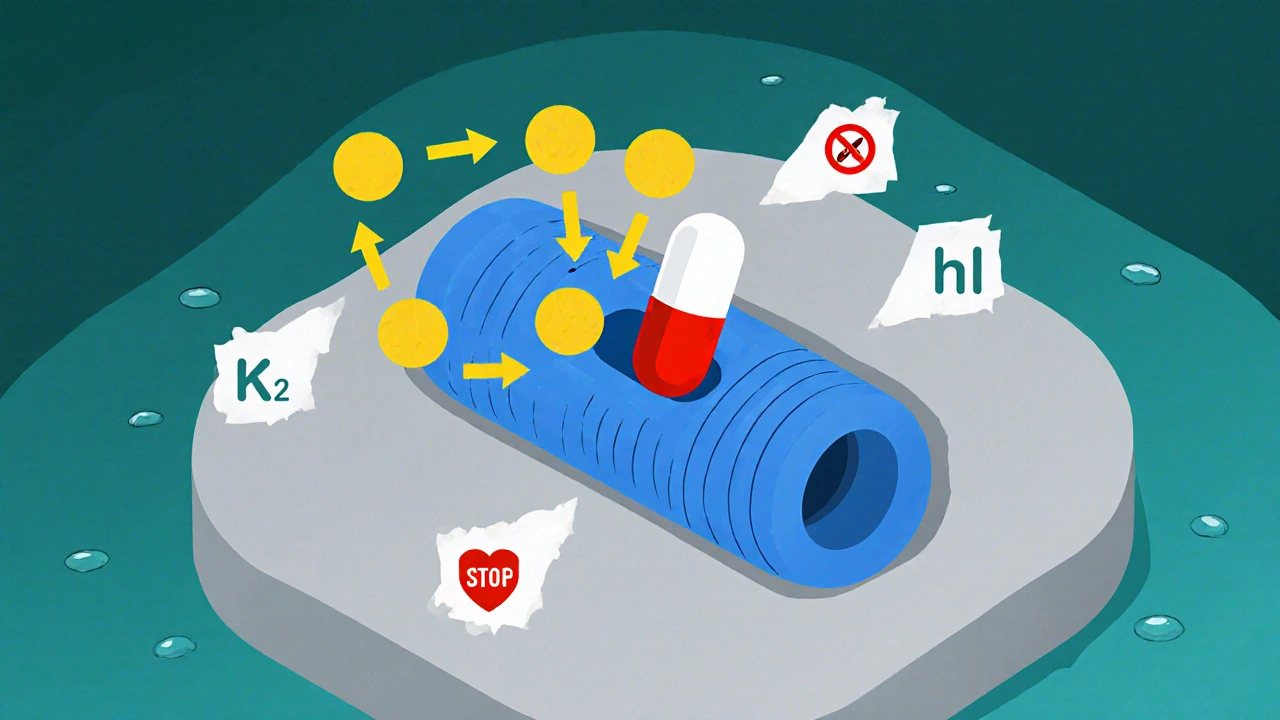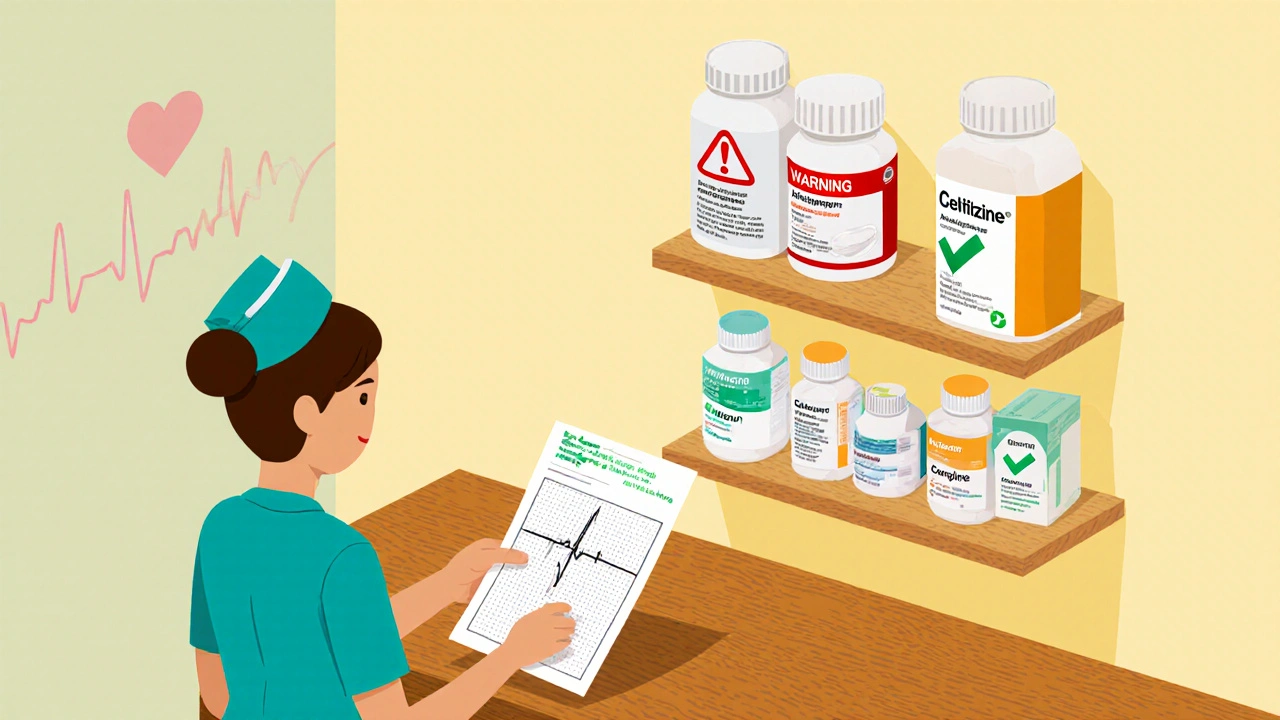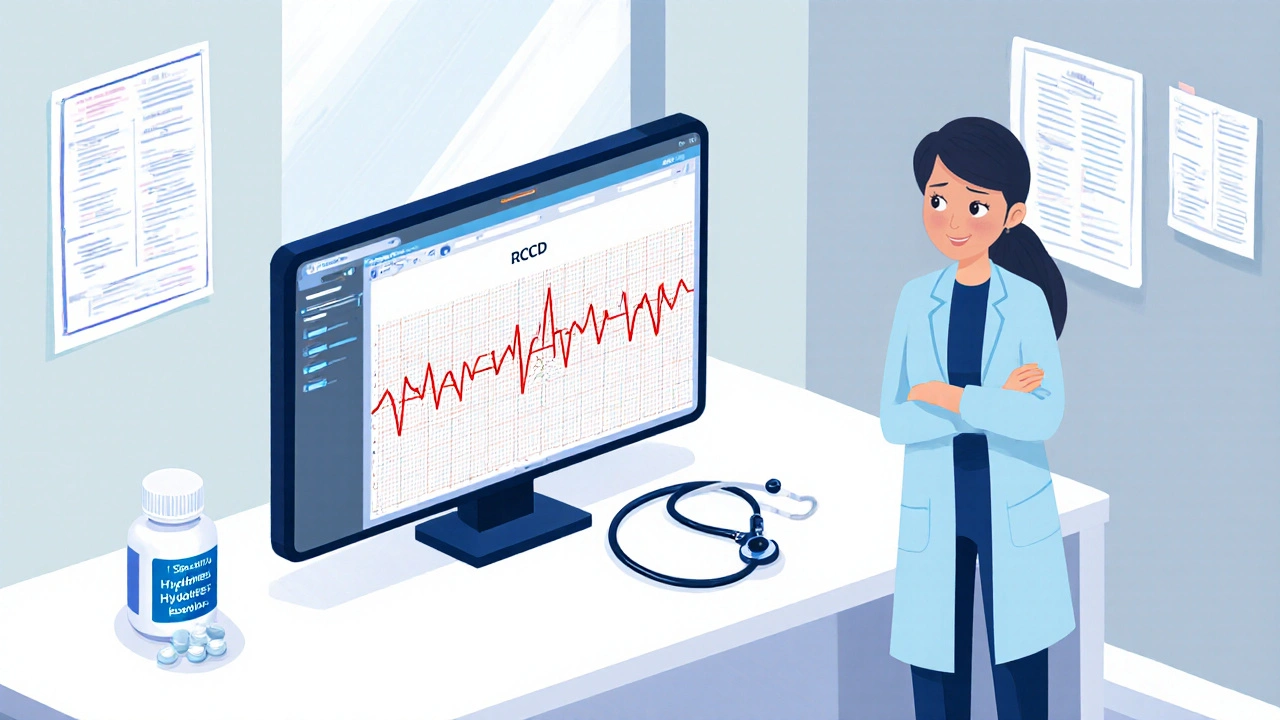Hydroxyzine QT Prolongation Risk Calculator
Patient Assessment
Risk Assessment
Clinical Recommendation
Key Considerations
Based on article guidelines:
- Limit dose to ≤50 mg/day for patients >65 years
- Check electrolytes and baseline ECG
- Consider safer alternatives like cetirizine or loratadine
- Monitor ECG 2-4 hours after first dose
Quick Summary
- Hydroxyzine can lengthen the QT interval, especially at higher doses or in vulnerable patients.
- Risk stems from hERG potassium‑channel blockade, leading to possible Torsade de Pointes.
- Assess QTc, electrolytes, and drug interactions before prescribing.
- Limit doses to ≤100 mg/day (≤50 mg for >65 yr) and monitor ECG when risk factors exist.
- Second‑generation antihistamines (e.g., cetirizine, loratadine) have far lower cardiac risk.
When a doctor writes a script for hydroxyzine, the focus is usually on anxiety, itch, or nausea. Rarely does anyone think about the heart‑beat changes it can cause. Yet a growing body of evidence shows that hydroxyzine has a dose‑dependent link to hydroxyzine QT prolongation. This article breaks down what the QT interval is, how hydroxyzine interferes with the heart’s electrical system, who is most at risk, and what practical steps clinicians can take to keep patients safe.
What is Hydroxyzine?
Hydroxyzine is a first‑generation antihistamine originally approved by the U.S. Food and Drug Administration (FDA) in 1956. It’s sold under brand names such as Atarax and Ucerax and is used for anxiety, pruritus, nausea, and as a sedative. Because it crosses the blood‑brain barrier, it produces a noticeable calming effect, which makes it popular in both primary care and specialty settings.
Despite its long market history, safety concerns have surfaced over the past two decades, especially regarding its impact on cardiac repolarisation.
How Hydroxyzine Affects the Heart: The QT Mechanism
The QT interval on an electrocardiogram (ECG) measures the time the heart’s ventricles spend repolarising - essentially resetting for the next beat. Prolongation of this interval can set the stage for a dangerous rhythm called Torsade de Pointes (TdP).
Laboratory studies pinpoint hydroxyzine’s culprit: inhibition of the human ether‑a‑go‑go‑related gene (hERG) potassium channel. The hERG channel is crucial for moving potassium out of cardiac cells during phase 3 of the action potential. Hydroxyzine binds to the inner cavity of the channel, reducing potassium efflux and lengthening repolarisation. Reported IC50 values sit within the range of therapeutic plasma concentrations, meaning even standard doses can affect the channel in susceptible individuals.

Clinical Evidence of QT Prolongation and TdP
Post‑marketing surveillance in the early 2000s flagged case reports of QT prolongation and TdP after hydroxyzine use. A 2015 European Medicines Agency (EMA) review compiled 59 reports between 1955 and 2016, confirming a small but real risk. Notable case series include:
- Acosta‑Materan et al., 2023 (Cureus): TdP occurred 10 min to 20 days after starting hydroxyzine, with cumulative doses ranging from 12.5 mg to 225 mg.
- Case of a 68‑year‑old woman (2022, Cureus): 50 mg dose combined with amiodarone led to TdP and required emergency cardioversion.
- 45‑year‑old man with undiagnosed long QT syndrome (2019, J Med Case Rep): Syncope 15 min after a 25 mg dose.
Pharmacovigilance databases now list hydroxyzine as a “Known Risk of TdP” drug (CredibleMeds). The risk is considered dose‑dependent and amplified by electrolyte disturbances, bradycardia, or concurrent QT‑prolonging medications.
Identifying Patients at High Risk
Before prescribing, clinicians should run a quick risk checklist:
- Obtain a baseline 12‑lead ECG. Confirm QTc < 450 ms (men) or < 470 ms (women).
- Review concomitant meds using the CredibleMeds list - watch for other “Known Risk” agents like amiodarone, sotalol, or certain antibiotics.
- Check electrolytes: potassium ≥ 4.0 mmol/L and magnesium ≥ 1.8 mg/dL are minimum targets.
- Assess age and renal/hepatic function. Elderly patients (> 65 yr) have slower clearance (half‑life 14‑25 h) and higher accumulation.
- Screen for inherited channelopathies (e.g., congenital long QT syndrome) or personal/family history of sudden cardiac death.
Patients with zero risk factors may receive standard dosing. One risk factor warrants dose reduction and closer ECG monitoring; two or more generally means avoiding hydroxyzine altogether.
Prescribing Safely: Dose Limits and Monitoring
Regulatory updates after the 2015 EMA review set clear caps:
- Adults: ≤ 100 mg per day.
- Elderly (> 65 yr): ≤ 50 mg per day.
- Children (≤ 40 kg): 2 mg·kg⁻¹ per day.
When a patient presents any QT‑risk factor, an ECG should be repeated 2‑4 hours after the first dose and then daily for the first week of therapy. Electronic health record (EHR) systems now often include hard stops if QTc > 500 ms or if a known‑risk drug is already on the patient’s list.

How Hydroxyzine Stacks Up Against Other Antihistamines
| Drug | Generation | Typical QTc Change (ms) | Known TdP Risk |
|---|---|---|---|
| Hydroxyzine | First | ~10-15 | Known (CredibleMeds) |
| Diphenhydramine | First | ~5-10 | Possible |
| Cetirizine | Second | ~0-2 | Minimal |
| Loratadine | Second | ~0-1 | Minimal |
| Citalopram (high dose) | SSRI | ~10 | Possible |
The table shows that hydroxyzine’s QT effect sits between diphenhydramine and the truly low‑risk second‑generation antihistamines. For patients with any cardiac concerns, opting for cetirizine or loratadine is generally safer.
Future Directions and Ongoing Research
Genetic studies are honing in on CYP2D6 poor metaboliser status as a potential predictor of heightened QT risk (OR 3.2). A 2024 clinical trial (NCT05678912) is testing whether routine ECG monitoring in patients with one risk factor reduces cardiac events. Meanwhile, pharmaceutical companies are designing hydroxyzine analogs (e.g., VH‑01) that retain antihistamine potency while showing 87 % less hERG inhibition in preclinical models.
Guidelines are moving toward stricter limits. The European Society of Cardiology is expected to restrict hydroxyzine to single‑dose procedural anxiety by 2025, essentially eliminating chronic use. Until those changes are finalized, clinicians must treat hydroxyzine like any other medication with QT risk-carefully assess, dose conservatively, and monitor.
Key Take‑aways for Clinicians
- Check baseline QTc and electrolytes before starting hydroxyzine.
- Stay under the recommended dose limits, especially in older adults.
- Avoid hydroxyzine in patients already on CredibleMeds “Known Risk” drugs.
- Consider a second‑generation antihistamine when itching or allergic symptoms are the main issue.
- Document the cardiac risk assessment in the medical record; many institutions now audit compliance.
Can a single low dose of hydroxyzine cause QT prolongation?
Yes, although the risk is much lower at doses ≤ 25 mg. In susceptible individuals-those with congenital long QT syndrome, electrolyte imbalances, or concurrent QT‑prolonging drugs-even a single dose can trigger measurable QTc changes.
How long does it take for hydroxyzine‑induced QT changes to appear?
QT prolongation can be seen as early as 10‑minutes after dosing, but most clinically relevant changes emerge within 2‑4 hours, coinciding with peak plasma levels.
Is ECG monitoring required for every patient prescribed hydroxyzine?
Routine ECG is not needed for low‑risk, young patients without cardiac history. However, any patient with one or more risk factors should have a baseline ECG and a follow‑up check within the first 24‑48 hours of therapy.
What alternatives are safest for itch in elderly patients?
Second‑generation antihistamines such as cetirizine or loratadine are preferred. For severe pruritus, gabapentin or low‑dose mirtazapine have shown efficacy without QT concerns.
Does hydroxyzine interact with common cardiac drugs like beta‑blockers?
Beta‑blockers alone do not prolong QT, but when combined with other QT‑prolonging agents (e.g., amiodarone) the additive effect can be dangerous. Always review the full medication list.


Lindy Hadebe
October 24, 2025 AT 17:52The article tries to sound scientific, but it glosses over the real-world frequency of hydroxyzine‑induced torsades. Most clinicians will never see a case, yet the piece inflates the danger to scare off a perfectly usable drug. It also fails to acknowledge that the QT prolongation at therapeutic doses is often within measurement noise. In practice, the risk is dwarfed by the far higher incidence of QT issues with many antidepressants. Bottom line: the hype is disproportionate to the evidence.
Dason Avery
October 24, 2025 AT 19:23Whoa, let’s not throw the baby out with the bathwater! 🚀 While the QT talk can sound scary, the key is smart prescribing and monitoring. Think of hydroxyzine as a tool: in the right hands it can still soothe anxiety without turning hearts into ticking time‑bombs. So, keep the ECG in the toolbox, not the panic button.
Kester Strahan
October 24, 2025 AT 21:20From a pharmacokinetic standpoint, hydroxyzine exhibits a high volume of distribution (Vd≈5‑6 L/kg) and a biphasic elimination that can accumulate especially in CYP2D6 poor metabolisers. The hERG blockade affinity (IC50≈1‑2 µM) overlaps with therapeutic plasma levels, making dose‑dependent QTc prolongation a plausible off‑target effect. Moreover, concomitant blockers of the same channel, like sotalol, produce a synergistic increase in QT interval variance. In short, the electrophysiological risk profile is not a myth but a quantifiable parameter that clinicians should model when drafting a regimen.
Doreen Collins
October 24, 2025 AT 22:43You nailed the PK point.
In practice, I always start with a baseline ECG for anyone over 60 or with electrolyte concerns, then titrate the dose slowly while checking labs every few days. This cautious approach lets us catch any QT drift before it becomes clinically relevant, and it also gives patients the reassurance they need to stay on therapy when it truly helps with itch or anxiety.
HILDA GONZALEZ SARAVIA
October 25, 2025 AT 00:40For primary‑care doctors who frequently prescribe hydroxyzine for nocturnal pruritus, a practical workflow can look like this: first, review the patient’s medication list for any known QT‑prolonging agents; second, order a quick BMP and a 12‑lead ECG if the patient is older than 65 or has a history of cardiac arrhythmia; third, if the QTc is under 450 ms (men) or 470 ms (women), start with 25 mg at night and schedule a follow‑up ECG in 48‑72 hours. If the QTc edge‑climbs toward 500 ms, discontinue immediately and consider switching to cetirizine. This stepwise protocol keeps the risk low while still addressing the symptom burden.
Ekeh Lynda
October 25, 2025 AT 02:20The reality is that many clinicians overlook the subtlety of electrolyte balance especially potassium levels this can be a silent driver of QT prolongation because the heart’s repolarization relies heavily on the outward potassium current when these levels dip below 4.0 mmol/L the risk of hydroxyzine induced torsades rises markedly especially when combined with other hERG blockers such as certain macrolide antibiotics the literature shows case reports where even a 25 mg dose precipitated ventricular arrhythmias in patients with marginal magnesium reserves therefore a diligent review of basic metabolic panel before initiating therapy becomes not just advisable but essential this vigilance does not require costly monitoring only a simple lab draw and a quick ECG interpretation can avert serious adverse events
Michelle Capes
October 25, 2025 AT 04:16I totally get the anxiety doctors feel when they see a QT report 🙁 . It’s scary but remember that a lot of patients tolerate hydroxyzine just fine when we keep an eye on their electrolytes and avoid mixing it with high‑risk meds . A gentle reminder to double‑check the med list and maybe grab a quick ECG before the first dose can make a big diff .
Dahmir Dennis
October 25, 2025 AT 05:40Oh, bravo, another heartfelt plea to ‘just check a lab’. As if the modern physician has endless time between juggling insurance forms, answering pager alerts, and managing cafeteria coffee queues. Surely a single ECG will magically transform hydroxyzine from a potential hazard into a harmless lullaby for itchy patients. Yet the real problem is the industry’s relentless push to market older antihistamines as inexpensive solutions while sidestepping the subtle cardiac calculus that only a handful of specialists seem to care about.
Tammy Watkins
October 25, 2025 AT 07:53Esteemed colleagues, the cardiovascular implications of hydroxyzine merit rigorous appraisal beyond anecdotal case reports.
First, the electrophysiological mechanism involves inhibition of the hERG potassium channel, a well‑documented substrate for QT interval prolongation.
Second, quantitative analyses indicate that the mean increase in QTc at therapeutic plasma concentrations ranges from eight to fifteen milliseconds, a magnitude that, while modest, can be clinically significant in predisposed individuals.
Third, populations at heightened risk include patients over the age of sixty‑five, those with renal or hepatic impairment, and individuals harboring congenital long‑QT syndromes.
Fourth, concomitant administration of other QT‑prolonging agents, such as macrolide antibiotics, fluoroquinolones, or certain antiarrhythmics, produces an additive effect that may precipitate torsades de pointes.
Fifth, electrolyte disturbances-particularly hypokalemia and hypomagnesemia-lower the threshold for arrhythmogenesis and should be corrected prior to initiation.
Sixth, guideline‑based practice recommends obtaining a baseline 12‑lead electrocardiogram with corrected QT calculation using Fridericia’s formula.
Seventh, if the baseline QTc exceeds 470 ms in women or 450 ms in men, alternative therapy should be strongly considered.
Eighth, in patients possessing a single risk factor, dose reduction to a maximum of fifty milligrams per day, coupled with repeat ECG monitoring within forty‑eight hours, is advisable.
Ninth, for those with two or more risk determinants, the prudent course is to avoid hydroxyzine entirely and select a second‑generation antihistamine such as cetirizine or loratadine.
Tenth, documentation of risk assessment, electrolyte status, and ECG findings in the electronic health record is essential for medico‑legal accountability.
Eleventh, institutional protocols increasingly incorporate hard stops in prescribing software when QTc thresholds are breached, thereby reinforcing clinical vigilance.
Twelfth, ongoing research into CYP2D6 polymorphisms suggests that genotypic screening may further stratify patients susceptible to excessive drug accumulation.
Thirteenth, emerging analogues of hydroxyzine designed to attenuate hERG binding are in pre‑clinical phases and hold promise for future therapeutics with reduced cardiac liability.
Fourteenth, until such agents become available, clinicians must balance the antihistaminic benefits against the quantifiable arrhythmic risk through individualized patient assessment.
In conclusion, a disciplined approach that integrates baseline ECG, electrolyte optimization, drug interaction review, and adherence to dosing limits will mitigate the cardiac hazards associated with hydroxyzine while preserving its therapeutic utility.
Dawn Bengel
October 25, 2025 AT 09:50Only Americans need worry about such over‑cautious regulations – our doctors know best 😏.